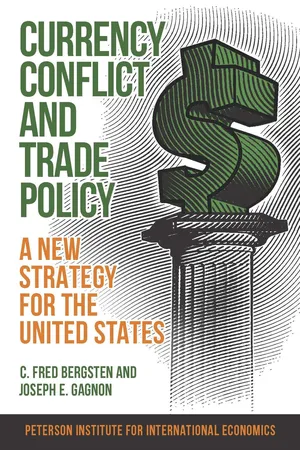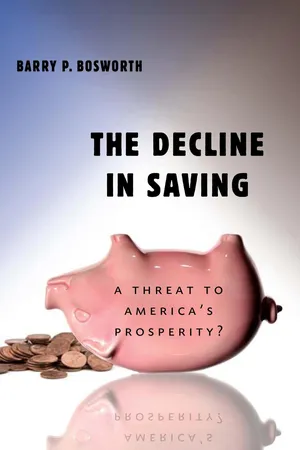Economics
Saving and the Current Account
Saving and the current account are interconnected in the economy. When a country saves more than it invests, it runs a current account surplus, and when it invests more than it saves, it runs a current account deficit. The current account measures the balance of trade in goods and services, net income, and net transfer payments.
Written by Perlego with AI-assistance
Related key terms
2 Key excerpts on "Saving and the Current Account"
- eBook - ePub
Currency Conflict and Trade Policy
A New Strategy for the United States
- C. Fred Bergsten, Joseph Gagnon(Authors)
- 2017(Publication Date)
2 Economic growth is typically measured as growth in the production of goods and services, also known as gross domestic product (GDP). In the economic accounts, GDP is measured as total domestic spending plus exports minus imports. Imports subtract from GDP because they are produced outside a country’s borders; an increase in “net exports of goods and services” adds to GDP growth and a decline in them reduces GDP growth. GDP, in turn, is a key driver of employment. Sizable and prolonged weakening of the trade balance can have a sufficiently negative effect on production and employment for a time to threaten the domestic political sustainability of a country’s international economic policies.The current account balance is the trade balance plus the balance in other transactions that reflect income paid to, or received from, the rest of the world. It is what matters for the financial sustainability of a country’s international economic position, because its cumulation over time determines whether a country is a net creditor or a net debtor to the rest of the world.Trade is by far the largest component of the current account for most countries. Movements in the current account balance are closely correlated with movements in the trade balance. Policies that affect the current account work largely through their effect on trade.DefinitionsThe current account is the net balance between all income received from foreigners and all payments made to foreigners. Income or payments may arise from trade (in goods or services), returns on existing investments (dividends and interest), wages earned in a foreign country, or unilateral transfers (charity or remittances to family members).The other main category of international transactions is the financial account, which includes all purchases and sales of real or financial assets. It includes direct investment by multinational corporations, portfolio investment by individuals and financial institutions, and the extension and repayment of loans. - eBook - ePub
The Decline in Saving
A Threat to America's Prosperity?
- Barry P. Bosworth(Author)
- 2012(Publication Date)
- Brookings Institution Press(Publisher)
This chapter first provides a global overview of recent trends in saving and investment that addresses some of the above concerns. It is based on aggregate measures of national saving and investment for about eighty-five countries over the period of 1980-2008. It then provides more detailed discussion of saving trends in other advanced economies (such as Canada, Japan, and Europe) that offers contrasts with and some insights into the U.S. experience. It concludes with an examination of saving behavior in China and India.Global ImbalancesNational patterns of saving and investment are linked globally through a simple accounting identity in which the difference between national saving and investment is equal to the external balance with the rest of the world, the current account:Furthermore, absent errors and omissions, the sum of the current accounts across all economies should equal zero. Thus, the deficits of some countries will be offset by the surpluses of others. Prior to the 1970s, current account imbalances were strictly limited, as most national financial markets operated as closed systems.2. With the emergence of large-scale cross-border capital flows, countries have become capable of financing increasingly large imbalances on a sustained basis.The dichotomy in the world economy between the external position of the United States and everyone else is highlighted in table 4-1 , which shows the current account balances for major regions in the world economy over the period of 1980-2010, providing a simple summary of the magnitude and distribution of the saving-investment (S-I) imbalances. The United States clearly stands out for the size of its recent deficit, which is matched by surpluses in all other regions. At the same time, Europe's surplus has grown modestly since the mid-1990s, and Japan's surplus has remained basically unchanged for nearly a quarter of a century. Similarly, little has changed in Latin America. The offsets to the increased U.S. deficit are large surpluses in the emerging economies of Asia and the oil-producing economies of the Middle East.3. Given the rise of oil prices, the surge of saving within the oil-producing regions is not a surprise, but the sudden emergence of a large excess of saving over investment in Asia is less expected. There is also a substantial current account discrepancy at the global level.4.
Learn about this page
Index pages curate the most relevant extracts from our library of academic textbooks. They’ve been created using an in-house natural language model (NLM), each adding context and meaning to key research topics.

